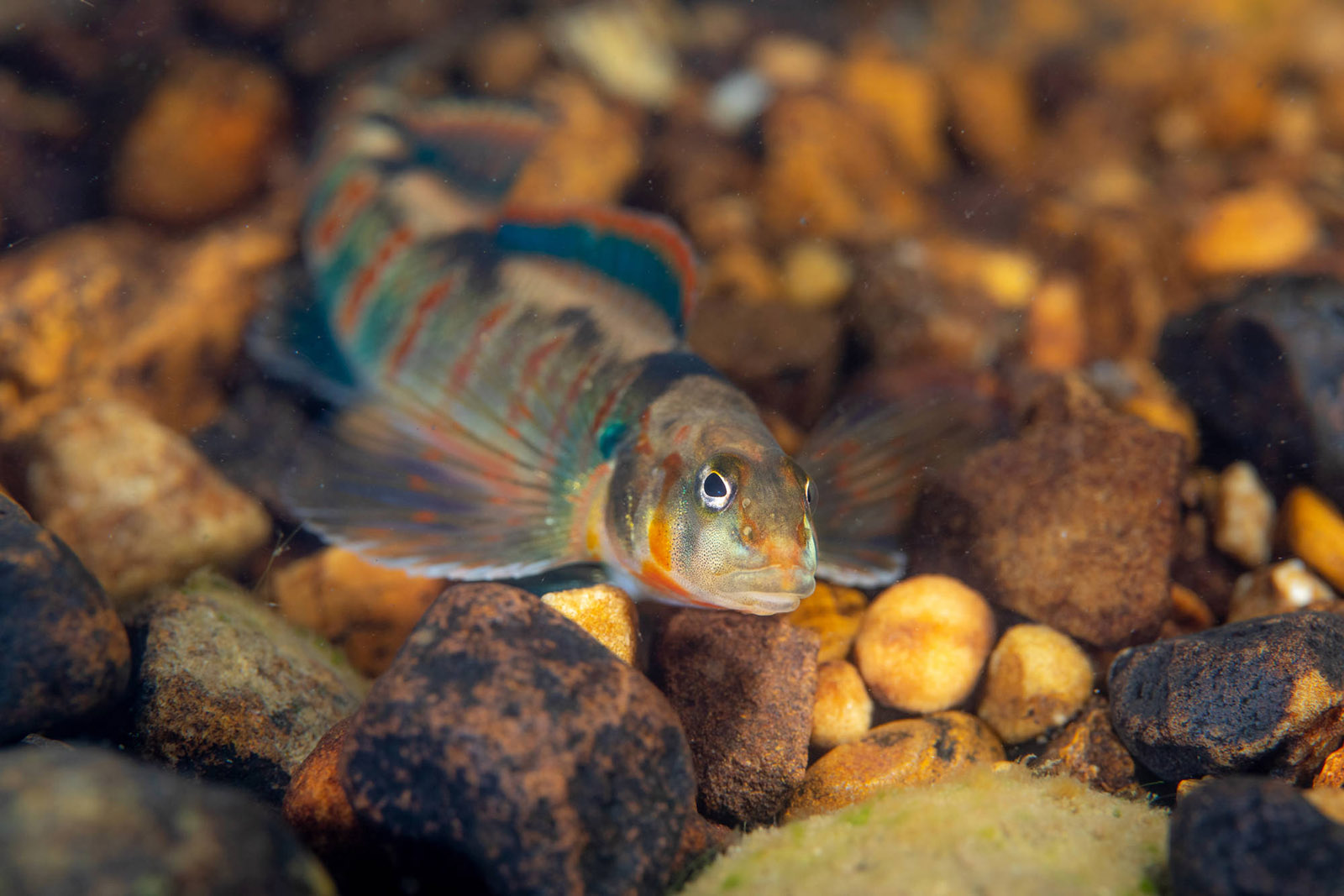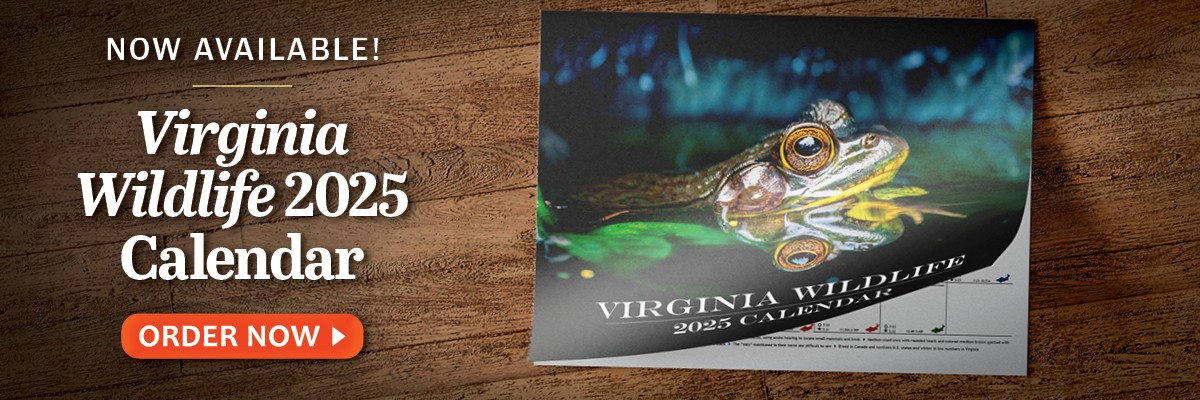By Molly Kirk/DWR
Freshwater fish in Virginia don’t come much more colorful than the candy darter! During breeding season (late winter through early spring), the male candy darter (Etheostoma osburni) sports vibrant, alternating vertical bands of red/orange and blue/green along its sides. The species provides a stunning splash of color in a few streams in the western parts of the commonwealth, but it’s a species that need help to survive for future generations to see.
Candy darters were added to the Federal List of Endangered and Threatened Wildlife in 2018 due to declining population ranges. Historically, there were 35 known populations of candy darters in their range, which includes the Gauley, Greenbrier and New river watersheds in Virginia and West Virginia. They’re not found anywhere else in the world, and now there are just 17 known populations of them in that area.
“It’s one of the most beautiful freshwater fish that we that we have in North America and rivals fish that you see in the tropics,” said Mike Pinder, nongame fish biologist for the Virginia Department of Wildlife Resources (DWR). “It’s a species that you typically find in clean rivers and streams, so for us as biologists, it’s an indicator of good water quality. This is a species that probably occurred in most streams and rivers in its range prior to European colonization. And now it’s really just hanging on in a few streams in Virginia and West Virginia. We’re lucky enough to have them where we can still go see them in sufficient numbers—they’re not confined to an aquarium or just a photo in a book. There’s still potential for recovery.”

Clean, fast-moving streams are ideal candy darter habitat. Photo by Mike Pinder/DWR
According to Pinder, the threats to the candy darter’s survival are the classic threats for many declining aquatic species: pollution, dams, and non-native species.
Pollution can include both point-source pollution—the direct release of chemicals into waters—and nonpoint-source pollution. “Nonpoint-source pollution is sedimentation, erosion coming off construction areas and poor forestry management areas, unrestricted cattle access to a waterway, or chemicals getting washed in from lawns, parking lots, or fields,” said Pinder.
“The candy darter’s range is littered with lots of small dams, many of which are not even functional anymore for their original purpose,” said Pinder. “That breaks up the species’ habitat. A species really needs to move from one area to another—it adds new genetic diversity to a population when we move from one population to another area. Dams block that. Some dams still in use are definitely serving a purpose, but we have to realize that we pay a price when we put in dams.”
The introduction of non-native species into a candy darter population can also have devastating effects. Pinder noted that there are 84 known species of fish in the New River system, and 44 of those are non-native. “People release fish either on purpose, like when they think, ‘Hey, I’d like to have this fish here to catch,’ or unintentionally, like they released their bait bucket. I’ve seen several introductions during my career here in the department,” said Pinder. “Some of those releases are pretty benign and not a big threat. But there are species released such as other darter species that are very closely related to the candy darter or use similar habits that can out-compete them for resources.”
In West Virginia, a sister species to the candy darter, the variegate darter, was introduced into the candy darter’s range, possibly via bait-bucket dumping. The two species are closely enough related that they’re starting to hybridize, so the pure strain of candy darters is essentially lost in those waters. “Luckily in Virginia, we don’t have the variegate darter problem yet,” Pinder said. “In this case, dams are kind of a double-edged sword because the Bluestone Reservoir stops those non-native fish from moving upstream into Virginia. But of course, somebody with a bait bucket can get over that dam. It’s a worry.”

Work is underway to help ensure that Virginia’s candy darter populations are secure. Photo by Ryan Hagerty/USFWS
With ESA funding, DWR has supported studies looking at life history of the species, its habitat use, and its population structure. Much of this research is in coordination with Virginia Tech. “We’re trying to get some basic information that you need in order to recover the population,” Pinder said. “If you don’t have this basic information, you can’t really move forward on recovery.” DWR works closely with the U.S. Fish and Wildlife Service (USFWS) and West Virginia Department of Natural Resources (DNR) on candy darter conservation efforts. “This species’ range is small, but it does include two states. It’s a lot of coordination, but it’s the Endangered Species Act that is the glue that puts us all together in a united effort,” said Pinder.
USFWS and DNR are working toward propagating candy darters at the White Sulphur Springs National Fish Hatchery in West Virginia, and those efforts will help Virginia’s populations as well, as Pinder would like to expand candy darter populations in certain streams. That’s where a lot of the research work comes into play. “You have to know where to put them; you can’t just pick any stream. You need to find a stream that has recovered and where they can survive,” explained Pinder. “That requires a lot of coordination, not only with our department, but with localities and other state and federal agencies. We are funding a candy darter study with Virginia Tech that helps us determine what streams would be the best to target for restoration and reintroduction. There are thousands of miles of streams, so it’s helpful to know where to be able to put the focus on for targeted recovery efforts.”
Pinder also works on dam removal and stream restoration projects to improve habitat for existing candy darter populations. “We’re trying to get the message across that protecting the candy darter isn’t just about protecting this one small fish—it’s actually about improving water quality. Water quality is important for everybody. Whether you’re a fish or a person, we all need clean water,” Pinder said.
“A lot of people always say, ‘What good is this one little animal?’ But we look at other countries and think, ‘I hope we always have elephants around, or tigers or pandas.’ But here we have a species that’s just as rare as any of those three in our own state,” said Pinder. “We’re lucky enough that they’re still present. They aren’t something we just look at a book and say, ‘That used to occur, but we were too careless to save it.’ But I think we’re still at a point that there are enough populations and there’s enough interest that we can recover this animal and hopefully one day de-list it from the ESA.”
Ways you can help the candy darter:
- Safely and properly dispose of household and industrial chemicals so they do not run directly into streams, and report chemical spills to state environmental protection agencies.
- Avoid building structures in streambeds, such as dams or rock stacks.
- Dump unused bait in the trash, not in streams or rivers
- During timber harvest, construction or other projects, implement best management practices for sediment and erosion control.
- Start a watershed group or assist in stream and water quality monitoring efforts.
- Plant trees and other native woody vegetation along stream banks to help restore and preserve water quality and prevent erosion.
- If you reside on property that borders a stream or other waterway, minimize use of chemicals or fertilizers and maintain a buffer of natural vegetation along stream banks to help control erosion and reduce runoff.


